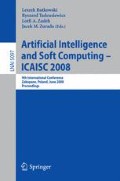Abstract
In the paper the new approach to create artificial neural networks (ANNs) is proposed. ANN’s are inspired by natural neural networks (NNNs) that receive data in time still tuning themselves. In opposite to them ANNs usually work on the training data (TD) acquired in the past and are totally available at the beginning of the adaptation process. Because of this the adaptation methods of the ANNs can be sometimes more effective than the natural training process observed in the NNNs. This paper presents the ability of ANNs to adapt more effectively than NNNs do if only all TD are known before the beginning of the adaptation process. The design and adaptation process of the proposed ANNs is divided into two stages. First, analyze or examining the set of TD. Second, the construction of neural network topology and weights computation. In the paper, two kinds of ANNs which use the proposed construction strategy are presented. The first kind of network is used for classification tasks and the second kind for feature extraction.
Access this chapter
Tax calculation will be finalised at checkout
Purchases are for personal use only
Preview
Unable to display preview. Download preview PDF.
References
Cichocki, A., Unbehauen, R.: Neural networks for optimization and signal processing. J. Wiley and Sons, New York (1993)
Duch, W., Korbicz, J., Rutkowski, L., Tadeusiewicz, R. (eds.): Biocybernetics and Biomedical Engineering. EXIT, Warszawa (2000)
Dudek-Dyduch, E.: Synthesis of feed forward neural network indicating extremes. Int. Journal System Analysis - Modelling - Simulation 24, 135–151 (1996)
Dudek-Dyduch, E., Bartman, J., Gomka, Z.: Detection of Edges using homogeneous neural network. In: Proc. of 7th Int. Conf. on Engineering Computer Graphics and Descriptive Geometry, Cracow, vol. 1, pp. 295–299 (1996)
Dudek-Dyduch, E., Dyduch, T.: On feedforward homogeneous layer neural nets. In: Proc. of the Second Conf. Neural Networks and Their Applications, Szczyrk, vol. 1, pp. 144–152 (1996)
Dudek-Dyduch, E., Dyduch, T.: Application of neural networks in 3D object recognition system. Int. Journal of Sample Recognition and Artificial Intelligence 12(4), 491–504 (1998)
Dudek-Dyduch, E., Horzyk, A.: Analytical Synthesis of Neural Networks for Selected Classes of Problems. In: Bubnicki, Z., Grzech, A. (eds.) Knowledge Engineering and Experts Systems, OWPN, Wroclaw, pp. 194–206 (2003)
Dudek-Dyduch, E., Tadeusiewicz, R.: Neural network indicating maxima and ridges in two-dimensional signal. In: Bulsari, A.B., Kallio, S. (eds.) Engineering Applications of ANN, Proc of Int. Conf. EANN 1995, Helsinki, pp. 485–488 (1995)
Dudek-Dyduch, E., Gomuka, Z., Pkala, R.: Adjusting parameters of two-dimensional neural network. In: Proc. of the Second Conf. Neural Networks and Their Applications, Szczyrk, vol. 1 (1996)
Dyduch, T., Dudek-Dyduch, E.: Application of neural networks to fringe samples analysis. In: Bulsari, A.B., Kallio, S. (eds.) Solving Engineering Problems with Neural Networks, Proc of EANN 1996, London, vol. 2, pp. 671–674 (1996)
Fiesler, E., Beale, R. (eds.): Handbook of Neural Computation. IOP Publishing Ltd. and Oxford University Press, Bristol and New York (1997)
Horzyk, A.: A New Extension of Self-optimizing Neural Networks for Topology Optimization. In: Duch, W., Kacprzyk, J., Oja, E., Zadrożny, S. (eds.) ICANN 2005. LNCS, vol. 3696, pp. 415–420. Springer, Heidelberg (2005)
Horzyk, A., Tadeusiewicz, R.: Comparison of Plasticity of Self-Optimizing Neural Networks and Natural Neural Networks. In: Mira, J., Alvarez, J.R. (eds.) Proc. of ICANN 2005, pp. 156–165. Springer, Heidelberg (2005)
Horzyk, A., Tadeusiewicz, R.: Self-Optimizing Neural Networks. In: Yin, F.-L., Wang, J., Guo, C. (eds.) ISNN 2004. LNCS, vol. 3173, pp. 150–155. Springer, Heidelberg (2004)
Jankowski, N.: Ontogenic neural networks, EXIT, Warszawa (2003)
Kacprzak, T., lot, K.: Cellular Neural Networks, PWN, Warszawa - d (1995)
Author information
Authors and Affiliations
Editor information
Rights and permissions
Copyright information
© 2008 Springer-Verlag Berlin Heidelberg
About this paper
Cite this paper
Dudek-Dyduch, E., Horzyk, A. (2008). The Influence of Training Data Availability Time on Effectiveness of ANN Adaptation Process. In: Rutkowski, L., Tadeusiewicz, R., Zadeh, L.A., Zurada, J.M. (eds) Artificial Intelligence and Soft Computing – ICAISC 2008. ICAISC 2008. Lecture Notes in Computer Science(), vol 5097. Springer, Berlin, Heidelberg. https://doi.org/10.1007/978-3-540-69731-2_4
Download citation
DOI: https://doi.org/10.1007/978-3-540-69731-2_4
Publisher Name: Springer, Berlin, Heidelberg
Print ISBN: 978-3-540-69572-1
Online ISBN: 978-3-540-69731-2
eBook Packages: Computer ScienceComputer Science (R0)

